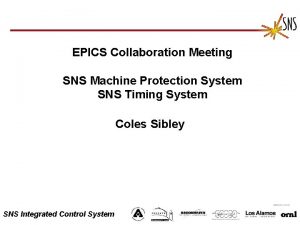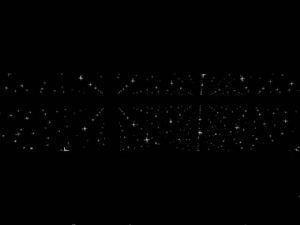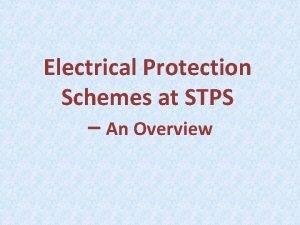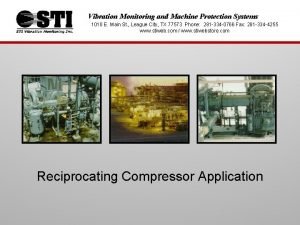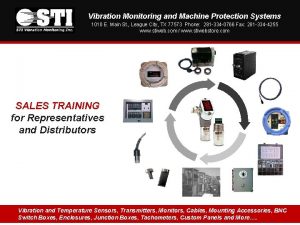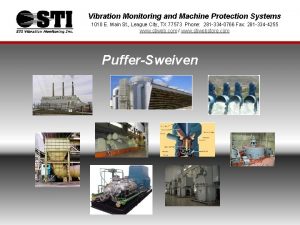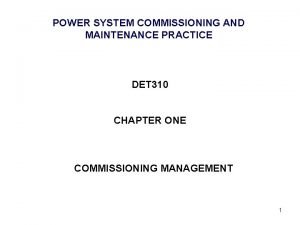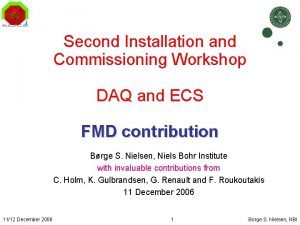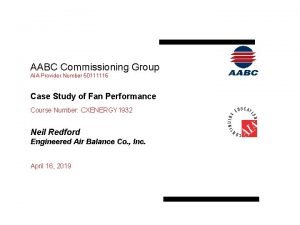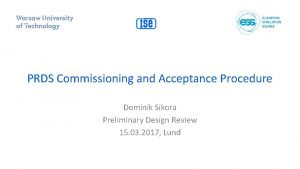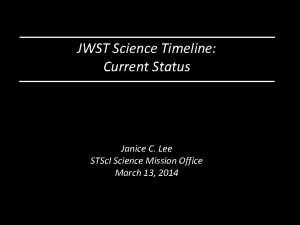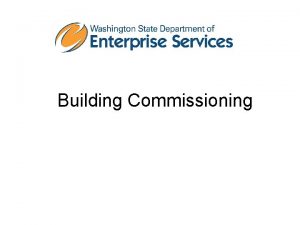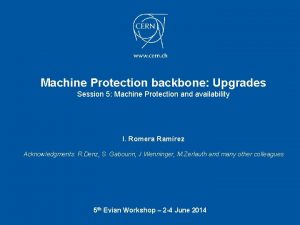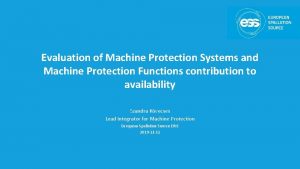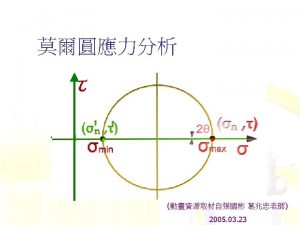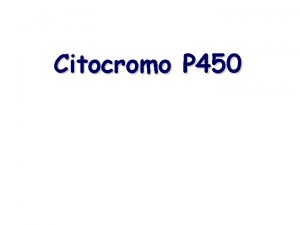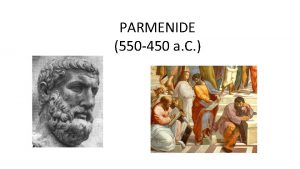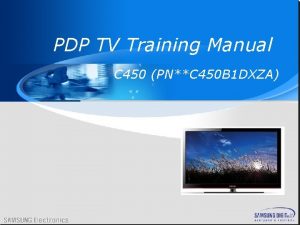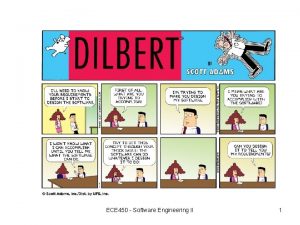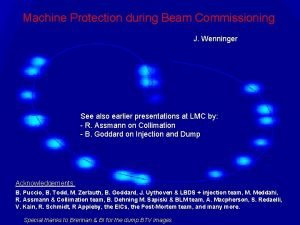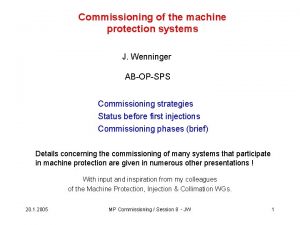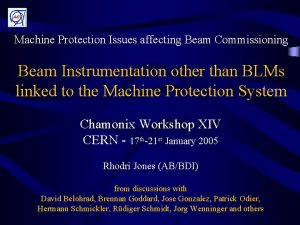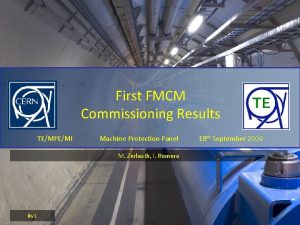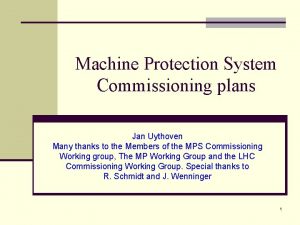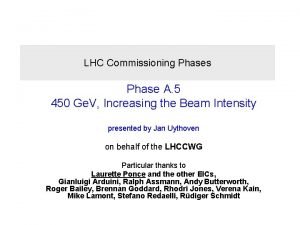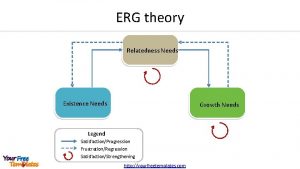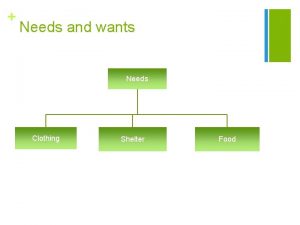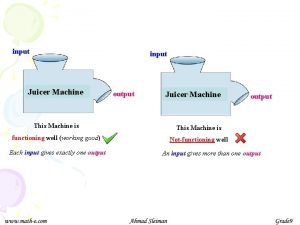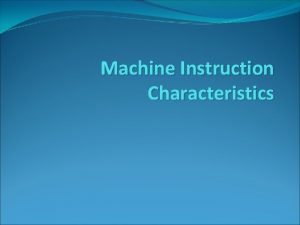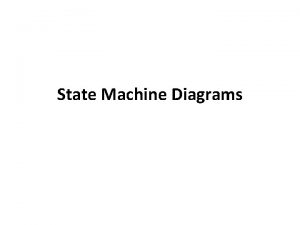450 Ge V Commissioning Machine Protection u Needs

























- Slides: 25

450 Ge. V Commissioning Machine Protection u Needs to be commissioned to: u u u The commissioning of the MPS needs to be well defined and procedures agreed upon BEFORE we get there u u u Good example JW note for CNGS commissioning: “Interlocked Equipment of the CNGS and LHC Transfer Lines”, edms 714582 u Took about 8 months to get this all written down and agreed For LHC @ injection: can not be treated in one presentation All MP systems should be active from the start of operation with and without beam u u u Prevent damage with the used, higher intensities at injection Prepare for the next phases of commissioning Avoid masking interlocks for start up Systems need to be verified once they are ‘obligatory’ = their protection is required Need a reliable limitation of LHC and SPS intensity! Jan Uythoven, AB/BT LHCCWG, 3 May 2006 1

First tests without beam Copy JU u 06” Commissioning of MPS and connected equipment u u “Cham First test in the laboratory Followed by equipment test in the machine Followed by hardware Commissioning u Equipment tests under ‘normal operating conditions’ u Interface between systems A maximum of functions should be tested without beam u u Individual equipment, interface between systems, Post Mortem analysis, Sequencer, Safe Beam Parameters, etc. Also if they can only be tested partially without beam, the partial tests should be done as soon as possible Jan Uythoven, AB/BT LHCCWG, 3 May 2006 2

Discussion : first pilot @ 450 Ge. V • Some very central systems will be tested and ready to go: • The Beam Interlock System • Key beam interlock clients: • Vacuum • Access Un-maskable input signals to the BIS • Powering interlock system • Dump system • Critical BLMs • Experiments(*) à Does not mean that those systems are 100% operational – e. g. Dump System From JW “ Cha m 06 ” (*) The experiments request un-maskable inputs, they must therefore be ready during the machine checkout with all other un-maskable inputs ! 3

Systems to Commission u The core of the system u u u All the systems connected to it u u u u The Beam Interlock System (BIS) The LHC Beam Dumping System (LBDS) BLM QPS – PIC – WIC FMCM Injection system Collimator System …. Related systems u u Hardware u Safe Beam Parameters u Beam Presence Flag Software u Post Mortem system u Management of critical settings u Software Interlock System u Sequencer Jan Uythoven, AB/BT LHCCWG, 3 May 2006 4

Machine Protection System and connected equipment Beam Current Monitors 4 x DCCT Dipole Current Safe LHC Parameters Energy Beam Energy Tracking Injection Kickers Safe. Beam Flag (4/5, 5/6, 6/7, 7/8) RF turn clock BLMs aperture Beam Dumping System BLMs arc Collimators / Absorbers Beam Dump Trigger Cryogenics BPMs for Beam Dump NC Magnet Interlocks Discharge Switches Power Converters LHC Beam Interlock System essential circuits Powering Interlock System d. I/dt magnet current RF + Damper LHC Experiments Vacuum System Operators Software Interlocks auxiliary circuits Timing BPMs for dx/dt + dy/dt d. I/dt beam current Screens AUG UPS SPS Extraction Interlocks TL collimators Access Safety System Quench Protection Energy PM Trigger Required also for safe beam Required for unsafe beam 5

Procedures u Need to check that previous diagram is complete u u Have to agree upon checks to be performed on these systems for the different phases u u u + Need to define the subsystems Phases also to be defined in more detail Check interplay between the different systems First outline on the next slides, based on “Chamo 06” presentations Jan Uythoven, AB/BT LHCCWG, 3 May 2006 6

Stages for Machine Protection Stage I Hardware commissioning Machine checkout Beam commissioning No beam Comm. before first beam 43 bunch operation ? Beam First pilot 0. 45 / 7 Te. V ‘Just’ SAFE at 7 Te. V 1012 protons 0. 45 / 7 Te. V II III 75 ns ops 25 ns ops I IV Install Phase II and MKB 25 ns ops II Beam 43 bunches 0. 45 / 7 Te. V 156 bunches 0. 45 / 7 Te. V 936 bunches 0. 45 / 7 Te. V SAFE at 450 Ge. V From JW “Cham 06” 7

Injection ” “ W J From 06 m a h C System Commissioning before beam possible ? Powering interlock system YES Beam interlock system YES Safe distribution of energy YES Safe beam flag PARTIAL Beam presence flag PARTIAL Safe distribution of mode Safe distr. of squeezing factor YES PARTIAL Beam interlocks SPS to LHC YES Injection protection NO Access system YES Vacuum system YES Magnet current change monitor YES BLMs, collimators & apertures PARTIAL BLM in the arcs PARTIAL Collimators and beam absorbers NO Beam position change monitors NO Fast beam current decay monitors NO Transverse feedback NO RF NO Experiments PARTIAL Beam Dumping System PARTIAL TCDQ / TCS NO BPM for BDS NO First pilot beam 10^12 See V. Kain’s presentation ! 43 bunches 1. 7 10^12 156 bunches 6 10^12<N<1. 4 10^13 936 bunches >5 10^13

Critical software Injection System Commissioning before beam possible ? Post-mortem PARTIAL Software Interlock System PARTIAL Critical settings management YES Sequencer First pilot beam 10^12 43 bunches 1. 7 10^12 156 bunches 6 10^12<N<1. 4 10^13 936 bunches >5 10^13 PARTIAL Checks will need to be repeated when going up in intensity! 9

Phases As taken from LHC-Com web pages u u Beam at 450 Ge. V safe up to of 1 e 12 p+, with nominal emittance Phase 1 u u u Will need to be (partly) re-checked for intensity dependent effects at the following sub stages u u u 1 x 1, 1 e 10 p/ bunch: safe 43 x 43, 3 e 10 p/bunch: int. in one beam = 1. 3 e 12 p+ Above the safe threshold: MP system needs to be commissioned at the first step of intensity increase Check again at 156 bunches Check again …intermediate… ? Check again at 936 bunches Check again at 2808 bunches Will need to repeat (part of) the check when operating conditions change u u Optics (squeeze ) Emittance Polarities of the magnets of the experiments Ion operation Jan Uythoven, AB/BT LHCCWG, 3 May 2006 10

Different Systems u Can only commission one system at a time. Proposed logical order of commissioning: 1. 2. 3. 4. 5. Injection System a) But needs some collimation Beam Dumping System a) But needs some collimation, BLMs and BPMs Other Systems – expected or unexpected beam dependence (BPMs, FMCM, noise pick-up in general) BLM System Collimation System Jan Uythoven, AB/BT LHCCWG, 3 May 2006 11

Injection System u Special injection BIC u u u Check all the inputs – can this be done completely without beam? additional input: SPS safe beam intensity, SPS intensity, LHC beam presence, LHC beam intensity, LHC energy TL collimation system u u u Mainly after the TI 8 TED, so can not be tested independently of the LHC 7 collimators per line (momentum TCDI at start of the lime) 6 betatron collimators in last 300 m u u TCDIs need beam for setting-up TCDI beam commissioning needs LHC beam permit Jan Uythoven, AB/BT LHCCWG, 3 May 2006 12

Injection System ctd. u Check setting of active element. These settings (MCS) and read backs will now need to be interlocked. Verify interlocking. u u u magnet currents with ROCS surveillance and Fast Magnet Current Change Monitor Septa, kickers (voltage and timing) Check position of protection elements u u u TDI, TCLIs, TCDD Alignment with beam, use transmission measurements Check that BLM readings in this area as expected TCLIs enhance performance of TDI. TCLIs are needed above 50% of nominal injected intensity and can be commissioned later Jan Uythoven, AB/BT LHCCWG, 3 May 2006 13

Systems concerned (3) Passive Protection: TDI-TCDD-TCLI • 4. 25 m long TDI, mask TCDD and auxiliary collimators TCLI to protect against MKI failures – setting for TDI-TCLI 6. 8 s to protect LHC at 7. 5 s – need beam for setting-up From VK “ Cham 06” ode M p m u nd D Inject a l: needs to be efu very us ioned s s i m m co V. Kain AB/OP 14

Systems concerned (6) Software • Software interlocking system (SIS) • Trajectories, screen positions, MCS, maximum allowed injection intensity … • Management of Critical Settings (MCS) • Remote management of interlock settings in a secure way (needs SIS) • MKI, MKE, TDI, TCLI, TCDI, ROCS, BLMs, BPCE, MSE • First version for extraction/transfer tests 2006. Single client. • Extraction/transfer/injection data analysis and diagnostics • Shot-by-shot beam quality check to allow next extraction/injection • Analysis after abnormal situation e. g. interlock (post mortem) • First versions planned for CNGS commissioning/Sector Test. • From LHC injection sequencer • setting-up of TDI/TCDD/TCLI • inject & dump V. Kain AB/OP VK “ Cham 06” 15

Timeline: Systems required for different almost commissioning stages Need everything 2006 2007 beam 1 beam 2 installed & prototype test needed, but may not be fully available V. Kain AB/OP installed & fully operational 16

Beam Dump System See u Check and optimise settings of active elements u u u ” TCDQ and TCS (partial commissioning required, setting at ± 10 ) u Dependence of collimator system and orbit feedback Check apertures MSD, MKD, TCDS, TCDQ, TCS, TCDQM Check that BLM readings agree with expectations IPOC, XPOC Interlock on PM ! Check re-triggering with beam (sweep across TCDS, TCDQ)? u u MKD, MSD, MKB u Check amplitude and fine timing (2 x 15 individual MKD systems) u Optimisation requires local HARDWARE changes! Check interlocking of these settings, BPM interlock LSS 6 m 06 Check Post Mortem, commissioning of the extraction lines (TD) u u “Cha Check and optimise settings of protection elements u u BG Commissioning of abort gap watchdog Present MKB system limits LHC max intensity at full energy to half nominal but full intensity up to 2 Te. V Jan Uythoven, AB/BT LHCCWG, 3 May 2006 17

BIC Systems u Injection BIC u Ring BIC u Can all be tested without beam? u u Additional tests with beam? u Want to see the whole chain working emc Jan Uythoven, AB/BT LHCCWG, 3 May 2006 18

BPM System u Check dependence of beam position on measured beam intensity u Number of bad BPMs acceptable? u Special attention: u u Interlocked BPMs in dump area u Test dumping beam for different orbits in dump area, part of tests LBDS Stability of beams, especially collimator area u Will need a working orbit feedback Jan Uythoven, AB/BT LHCCWG, 3 May 2006 19

BLM System u Check dependence of measured beam losses on beam intensity u u u All linear? Agrees with models? Differences understood? If not: acceptable? Test a beam dump initiated by a BLM, triggered by beam loss? Procedures of adjusting BLM thresholds (MPWG) Jan Uythoven, AB/BT LHCCWG, 3 May 2006 20

Collimators u See talk Ralph u Collimators interaction with u u Injection system collimators Beam dumping system collimators Beam loss monitors (for setting up) Beam position monitors (for setting up) u Orbit feedback u Interaction u with optics Beta beat u Need ‘global coordination’ Jan Uythoven, AB/BT LHCCWG, 3 May 2006 21

Safe Beam Flag u Need to check the proper functioning of the safe beam flag u In this stage only intensity dependence Jan Uythoven, AB/BT LHCCWG, 3 May 2006 22

Systems not discussed in detail u u Further QPS tests? RF u u phasing with LBDS, max frf d. I/dt beam current Screens out Software interlocks Jan Uythoven, AB/BT LHCCWG, 3 May 2006 23

Conclusions and Discussion u u u The Machine Protection System is complicated, already at injection Many tests can be done before beam operation (esp. BIC) Main systems identified u u This presentation is useless without follow-up u u u Soon! Sub-groups? Detailed and agreed upon procedures will be required u u BIC, Injection, LBDS, BLMs, Collimators Other systems…. (MCS, QPS, FMCM, d. I/dt, Software interlocks, Sequencer) Many cross links between systems Start with overview tables as presented at Chamonix by JW and VK Define more details u By the people responsible for equipment or systems u Plus check links between the different systems Document procedures and check consistency (see next talk: “LHCCWG Web Follow Up”) Documentation of test results required u Profit from experience of Hardware Commissioning? Jan Uythoven, AB/BT LHCCWG, 3 May 2006 24

Conclusions and Discussion, ctd. u How do we move between the different phases of MPS commissioning? u u u Use sequencer to be sure not to run outside the bounds of commissioned operating conditions? u Is this safe enough? u Operation in certain mode allowed, depending on u Intensity, Energy, Squeeze, Ions, … u Who is looking after the sequencer, what will it do? Use Safe Beam Parameter system to create interlock when “intensity x energy” is outside the commissioned region? ICFA-HB 2006 workshop end of this month u u Session on commissioning MP Systems Experience from other labs Jan Uythoven, AB/BT LHCCWG, 3 May 2006 25
 Trigonometri adalah
Trigonometri adalah Primary needs and secondary needs
Primary needs and secondary needs Strategic gender needs and practical gender needs
Strategic gender needs and practical gender needs Primary needs and secondary needs
Primary needs and secondary needs Target needs and learning needs in esp
Target needs and learning needs in esp Primary needs and secondary needs
Primary needs and secondary needs Machine protection system
Machine protection system Machine protection system
Machine protection system Generator over voltage protection
Generator over voltage protection Machine protection systems
Machine protection systems Machine protection systems
Machine protection systems Turbine supervisory instrumentation
Turbine supervisory instrumentation Integrated commissioning and progress system
Integrated commissioning and progress system Power system commissioning
Power system commissioning Ecs commissioning
Ecs commissioning Steps
Steps Commissioning
Commissioning Commissioning cycle
Commissioning cycle Nihr ccf
Nihr ccf Heat pump balance point
Heat pump balance point Croydon clinical commissioning group
Croydon clinical commissioning group Aabc commissioning group
Aabc commissioning group Value based commissioning
Value based commissioning Commissioning cycle
Commissioning cycle Commissioning
Commissioning Jwst timeline
Jwst timeline






